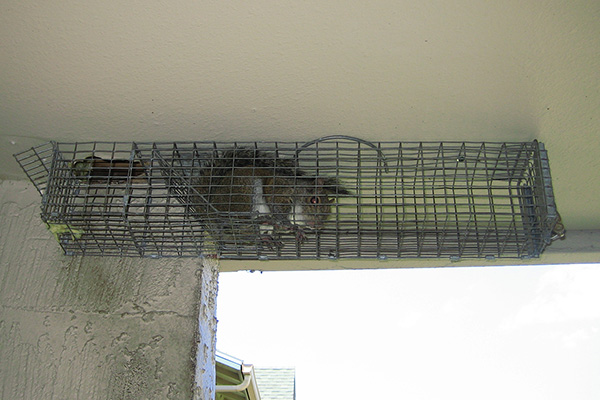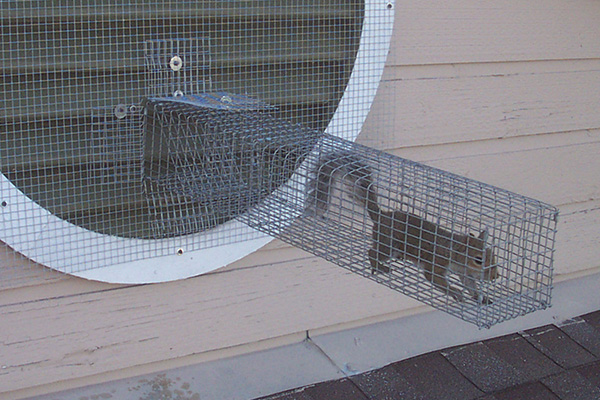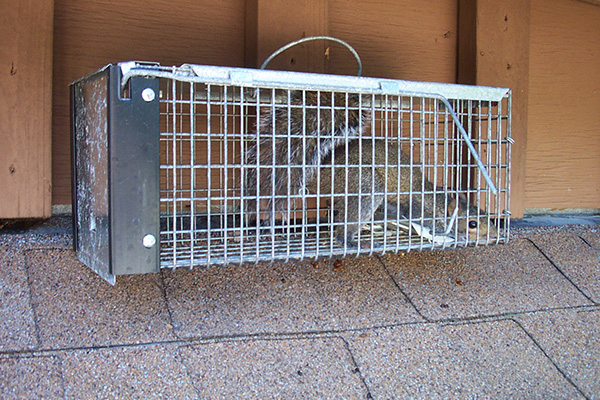- info@animalatticpest.com
- Call - we service 300 locations

How to Trap Squirrels - Squirrel Trapping Tips
Okay! After you've inspected your house and found the entry holes, and inspected the attic and confirmed the presence of squirrels, it's time to trap them, right? Maybe. You want to get the squirrels out of your attic. Sometimes trapping is the best answer. But first, consider excluding them with a one-way door. Here's the principle: the squirrels in your attic exit and re-enter the attic several times each day. They have to get water and food. So all you have to do is isolate their primary entry hole, and mount a special one-way door over it. This door allows the squirrels to exit, but not get back in. It's usually the best way to do it. Read more about exclusion with a one-way door. But sometimes trapping is the best method, especially if you can't have the squirrels on your roof or property anymore, such as when they are able to chew on your house woodwork and find their way back inside. In that case, you'll want to relocate them at least 10 miles away.
Photographs of Various Squirrel Trapping Sets
Repeater Trap Mounted on Hole
If trapping, this is the most common setup. Isolate the primary entry/exit hole, and mount a repeater trap, which catches all the squirrels at once as they exit.
Multiple Traps Bolted to Soffit Opening
In this case there was a wide hole, so I mounted two traps over the hole, with nose cones, to catch all the squirrels as they came out of the eave area of the attic.
Screened Vent With Repeater Trap
Squirrels were going in/out of this gable vent, so I installed a steel screen and mounted the repeater trap to give them no exit, and catch them as they emerged.
Information and Tips About Squirrel Trapping
Squirrel Trapping Tip #1 Never set a trap inside the attic itself. Squirrels simply will not enter a trap inside the attic. I don't know why this is, but it's simply a true part of squirrel behavior.
They will only enter a trap outside.
Squirrel Trapping Tip #2 The best trap is actually a repeater trap. See the below photos. This is a trap that you mount over the squirrel exit hole. As the squirrels come out for their daily water and food,
they will go into the trap, which can catch up to seven or eight squirrels at a time! You can get them all in one go.
Squirrel Trapping Tip #3 Be aware that there is almost surely a mother squirrel with babies in the attic. The babies grow quickly, to adult size and mobile in about 6 weeks. But if you catch a single female
with nipples and no other squirrels, the young are trapped inside! In that case, you must let the mother go, and wait for the young to grow to 6 weeks old. Don't worry, you can easily catch her again, with the other 4-5 young
squirrels. This is also the case with squirrels in a chimney. Read about How To Get Squirrels Out Of A Chimney.
Squirrel Trapping Tip #4 If you can't bolt this trap on the exit hole for some reason, you must set individual cage traps. Set 5-6 traps, to get all the squirrels. If you want to avoid catching every squirrel
in the neighborhood, and have a high chance of success at the squirrels in your attic, bolt the traps on the roof or the eaves or fascia boards near the entry holes. Be sure to set the traps in the shade! A squirrel in a trap
is already stressed, and heat on a roof can kill it in a matter of a couple hours, or less.
Squirrel Trapping Tip #5 A repeater trap needs no bait. But if you're using cage traps, spread peanut butter on the trap pan, and put whole peanuts in the shell on the peanut butter. Seeds work fine, too. Squirrels
are pretty easy to trap, you just want to be sure to get the right ones. If a squirrel is reluctant to enter the repeater trap, thirst becomes the top priority, and in that case, orange slices are actually best.
Read more about squirrel bait here.
Squirrel Trapping Tip #6 Relocate any trapped squirrels as quickly as possible. They almost always injure themselves frantically running back and forth in the cage trap, ramming thier heads. They can also
quickly succumb to heat stroke or death by exhaustion. And to be sure they don't come back to your house, relocate them at least 10 miles away. That may seem further than necessary, but animals are amazing at tracking
their way home.
The Bottom Line
Trapping squirrels in the attic. Remember, do not set cage traps inside the attic. Mount traps to the entry/exit holes, or set cage traps bolted on the roof, in the shade. But the best strategy of all is to not even trap the squirrels at all! The use of a one-way exclusion door is usually the best, the easiest, and the most humane method. You can trap squirrels in the attic if you follow the correct approach. Best of luck!




